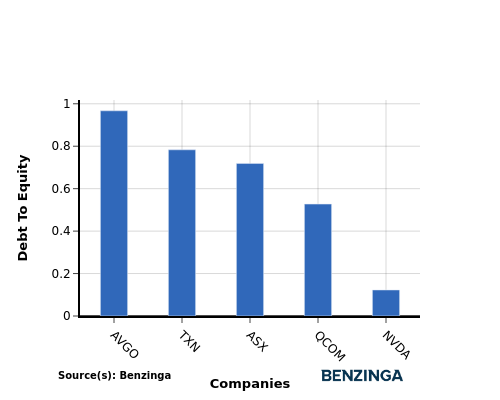Industry Comparison: Evaluating NVIDIA Against Competitors In Semiconductors & Semiconductor Equipment Industry
In today's rapidly changing and fiercely competitive business landscape, it is vital for investors and industry enthusiasts to carefully evaluate companies. In this article, we will perform a comprehensive industry comparison, evaluating NVIDIA (NASDAQ:NVDA) against its key competitors in the Semiconductors & Semiconductor Equipment industry. By analyzing important financial metrics, market position, and growth prospects, we aim to provide valuable insights for investors and shed light on company's performance within the industry.
NVIDIA Background
Nvidia is a leading developer of graphics processing units. Traditionally, GPUs were used to enhance the experience on computing platforms, most notably in gaming applications on PCs. GPU use cases have since emerged as important semiconductors used in artificial intelligence. Nvidia not only offers AI GPUs, but also a software platform, Cuda, used for AI model development and training. Nvidia is also expanding its data center networking solutions, helping to tie GPUs together to handle complex workloads.
| Company | P/E | P/B | P/S | ROE | EBITDA (in billions) | Gross Profit (in billions) | Revenue Growth |
|---|---|---|---|---|---|---|---|
| NVIDIA Corp | 55.28 | 49.85 | 28.54 | 23.01% | $22.58 | $26.67 | 69.18% |
| Broadcom Inc | 105.19 | 19.48 | 24.39 | 7.12% | $8.02 | $10.2 | 20.16% |
| Advanced Micro Devices Inc | 114.60 | 4.40 | 9.24 | 1.23% | $1.59 | $3.74 | 35.9% |
| Texas Instruments Inc | 40.64 | 11.88 | 12.28 | 7.08% | $1.85 | $2.31 | 11.14% |
| Qualcomm Inc | 16.22 | 6.30 | 4.23 | 10.3% | $3.67 | $6.04 | 16.93% |
| ARM Holdings PLC | 215.89 | 25.08 | 42.96 | 3.17% | $0.46 | $1.21 | 33.73% |
| Micron Technology Inc | 20.40 | 2.50 | 3.79 | 3.79% | $4.33 | $3.51 | 36.56% |
| Analog Devices Inc | 65.35 | 3.41 | 12.21 | 1.63% | $1.2 | $1.61 | 22.28% |
| Monolithic Power Systems Inc | 19.33 | 10.62 | 14.76 | 4.17% | $0.18 | $0.35 | 39.24% |
| STMicroelectronics NV | 27.81 | 1.66 | 2.50 | 0.32% | $0.51 | $0.84 | -27.36% |
| ON Semiconductor Corp | 42.05 | 3.15 | 3.90 | -5.78% | $-0.37 | $0.29 | -22.39% |
| ASE Technology Holding Co Ltd | 20.37 | 2.15 | 1.11 | 2.39% | $27.16 | $24.89 | 11.56% |
| First Solar Inc | 15.15 | 2.34 | 4.50 | 2.59% | $0.35 | $0.34 | 6.35% |
| United Microelectronics Corp | 11.84 | 1.42 | 2.32 | 2.06% | $23.86 | $15.45 | 5.91% |
| Credo Technology Group Holding Ltd | 330.14 | 24.11 | 39.71 | 5.63% | $0.04 | $0.11 | 179.73% |
| Skyworks Solutions Inc | 28.41 | 1.84 | 2.96 | 1.11% | $0.22 | $0.39 | -8.87% |
| Qorvo Inc | 151.60 | 2.41 | 2.26 | 0.93% | $0.11 | $0.37 | -7.6% |
| Rambus Inc | 36.08 | 6.38 | 12.37 | 5.29% | $0.08 | $0.13 | 41.4% |
| Lattice Semiconductor Corp | 140.95 | 10.13 | 14.75 | 0.71% | $0.02 | $0.08 | -14.68% |
| Average | 77.89 | 7.74 | 11.68 | 2.99% | $4.07 | $3.99 | 21.11% |
Through a thorough examination of NVIDIA, we can discern the following trends:
-
The Price to Earnings ratio of 55.28 is 0.71x lower than the industry average, indicating potential undervaluation for the stock.
-
The elevated Price to Book ratio of 49.85 relative to the industry average by 6.44x suggests company might be overvalued based on its book value.
-
The Price to Sales ratio of 28.54, which is 2.44x the industry average, suggests the stock could potentially be overvalued in relation to its sales performance compared to its peers.
-
With a Return on Equity (ROE) of 23.01% that is 20.02% above the industry average, it appears that the company exhibits efficient use of equity to generate profits.
-
The company has higher Earnings Before Interest, Taxes, Depreciation, and Amortization (EBITDA) of $22.58 Billion, which is 5.55x above the industry average, indicating stronger profitability and robust cash flow generation.
-
The company has higher gross profit of $26.67 Billion, which indicates 6.68x above the industry average, indicating stronger profitability and higher earnings from its core operations.
-
With a revenue growth of 69.18%, which surpasses the industry average of 21.11%, the company is demonstrating robust sales expansion and gaining market share.
Debt To Equity Ratio

The debt-to-equity (D/E) ratio assesses the extent to which a company relies on borrowed funds compared to its equity.
Considering the debt-to-equity ratio in industry comparisons allows for a concise evaluation of a company's financial health and risk profile, aiding in informed decision-making.
By analyzing NVIDIA in relation to its top 4 peers based on the Debt-to-Equity ratio, the following insights can be derived:
-
Among its top 4 peers, NVIDIA has a stronger financial position with a lower debt-to-equity ratio of 0.12.
-
This indicates that the company relies less on debt financing and maintains a more favorable balance between debt and equity, which can be viewed positively by investors.
Key Takeaways
For NVIDIA in the Semiconductors & Semiconductor Equipment industry, the PE, PB, and PS ratios indicate that the company is undervalued compared to its peers. However, the high ROE, EBITDA, gross profit, and revenue growth suggest strong financial performance and growth potential relative to industry competitors.
This article was generated by Benzinga's automated content engine and reviewed by an editor.
Posted-In: BZI-IANews Markets Trading Ideas


